First month for free!
Get started
Published 10/23/2025

In the quest for greater productivity and accessibility, converting spoken words into written text has become a critical need. Whether you're a developer integrating transcription into an application, a business needing to document meetings, or a content creator transcribing interviews, the right tool can save you hundreds of hours. This guide cuts through the noise to deliver a detailed analysis of the best free speech to text software available today. We go beyond simple feature lists to provide a practical resource for making an informed decision.
This article offers a comprehensive breakdown of top-tier options, from simple, built-in dictation tools like Google Docs Voice Typing and Apple Dictation to powerful, developer-focused APIs like Deepgram and OpenAI's Whisper. Each entry provides a hands-on assessment, complete with direct links and screenshots, to show you exactly how each platform performs. We will explore key features, honest limitations, and specific use cases for every tool listed.
Our goal is to help you quickly identify the ideal solution for your specific project. Whether you need a user-friendly dictation app for daily notes or a robust, scalable API for a complex software build, you will find the critical insights needed to choose the right software and implement it effectively. Let's dive in and find the perfect tool to transform your voice into text.
For users already embedded in the Google ecosystem, Voice Typing is a standout piece of free speech to text software built directly into Google Docs. It requires no installation or separate account; if you have a Google account, you have access. This seamless integration is its greatest strength, allowing you to dictate essays, meeting notes, or first drafts directly into a document with surprising accuracy.
The tool supports over 100 languages and dialects, making it highly accessible globally. Its real-time transcription is impressive, with words appearing almost instantly as you speak. Users can also use voice commands for basic formatting and editing, such as "new paragraph," "select word," or "go to the end of the line," which enhances hands-free productivity. The interface is clean and unobtrusive, appearing as a simple microphone icon in the "Tools" menu.
While it lacks the advanced features of dedicated transcription services, like speaker identification or automatic timestamping, it excels at straightforward dictation. It's a perfect choice for students, writers, and professionals who need a quick, reliable, and entirely free way to convert spoken words into text without leaving their primary word processor.
Microsoft has integrated powerful free speech to text software directly into its latest operating system, making it an excellent native option for Windows users. Accessible via a simple keyboard shortcut (Win + H), Voice Typing allows for system-wide dictation in any text field, from web browsers to notepads. This tool is designed for quick, on-the-fly transcription and includes features like auto-punctuation to streamline the writing process. Its biggest advantage is being built into the OS, requiring no downloads or external accounts to get started.

Beyond simple dictation, Windows 11 also offers Voice Access, a more robust accessibility tool that provides full hands-free control of the PC. While Voice Typing focuses on converting speech to text, Voice Access allows users to author documents, navigate apps, and manage their system entirely through voice commands. Uniquely, Voice Access can function entirely offline after an initial setup, providing reliable performance without a constant internet connection. This makes it a superior choice for users focused on accessibility and productivity across the entire Windows environment.
For those integrated into the Apple ecosystem, Apple Dictation is a powerful and deeply integrated piece of free speech to text software. It is built directly into iOS, iPadOS, and macOS, allowing users to dictate text anywhere they can type, from Messages and Notes to third-party applications. This system-wide availability means there are no new apps to install or accounts to create; it simply works out of the box on Apple hardware.
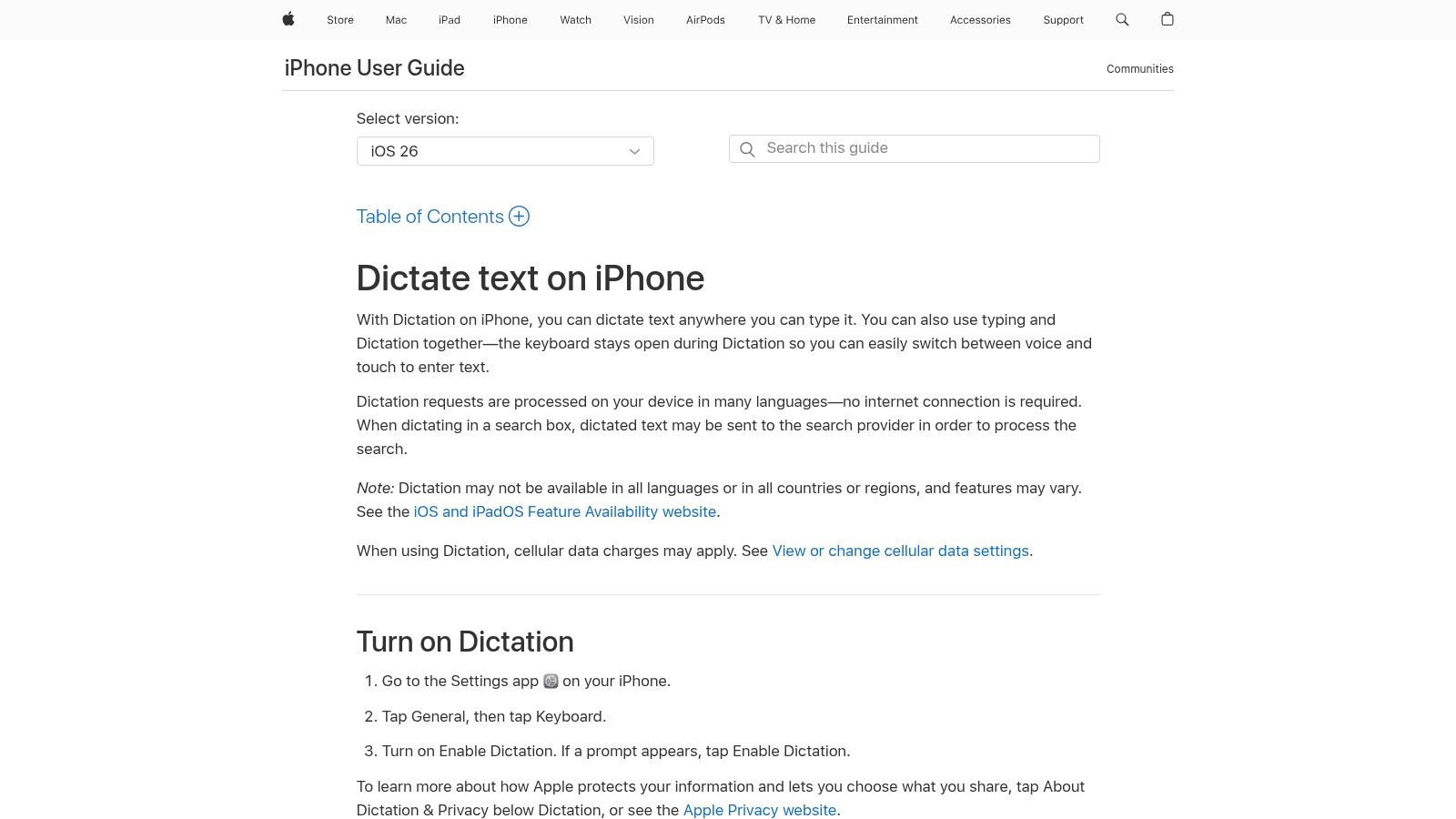
A key advantage is its on-device processing for many major languages, which enhances both speed and privacy by not sending your voice data to the cloud. The software is intelligent enough to handle auto-punctuation and lets users seamlessly switch between speaking and typing without manually changing modes. This makes it incredibly efficient for quick replies, drafting documents, or capturing thoughts on the go.
While it's not designed for long-form transcription with advanced features like speaker differentiation, its convenience is unmatched for daily use. It excels at converting short-to-medium length spoken passages into text with impressive accuracy and responsiveness, making it a go-to tool for millions of Apple users.
Otter.ai is a powerful transcription tool specifically designed for meetings, interviews, and lectures. As a piece of free speech to text software, its free tier offers a compelling suite of features that go far beyond simple dictation. It excels at recording conversations and automatically generating rich, searchable notes complete with speaker identification, timestamps, and summary keywords. This makes it an invaluable asset for anyone who needs to capture and recall detailed discussions.
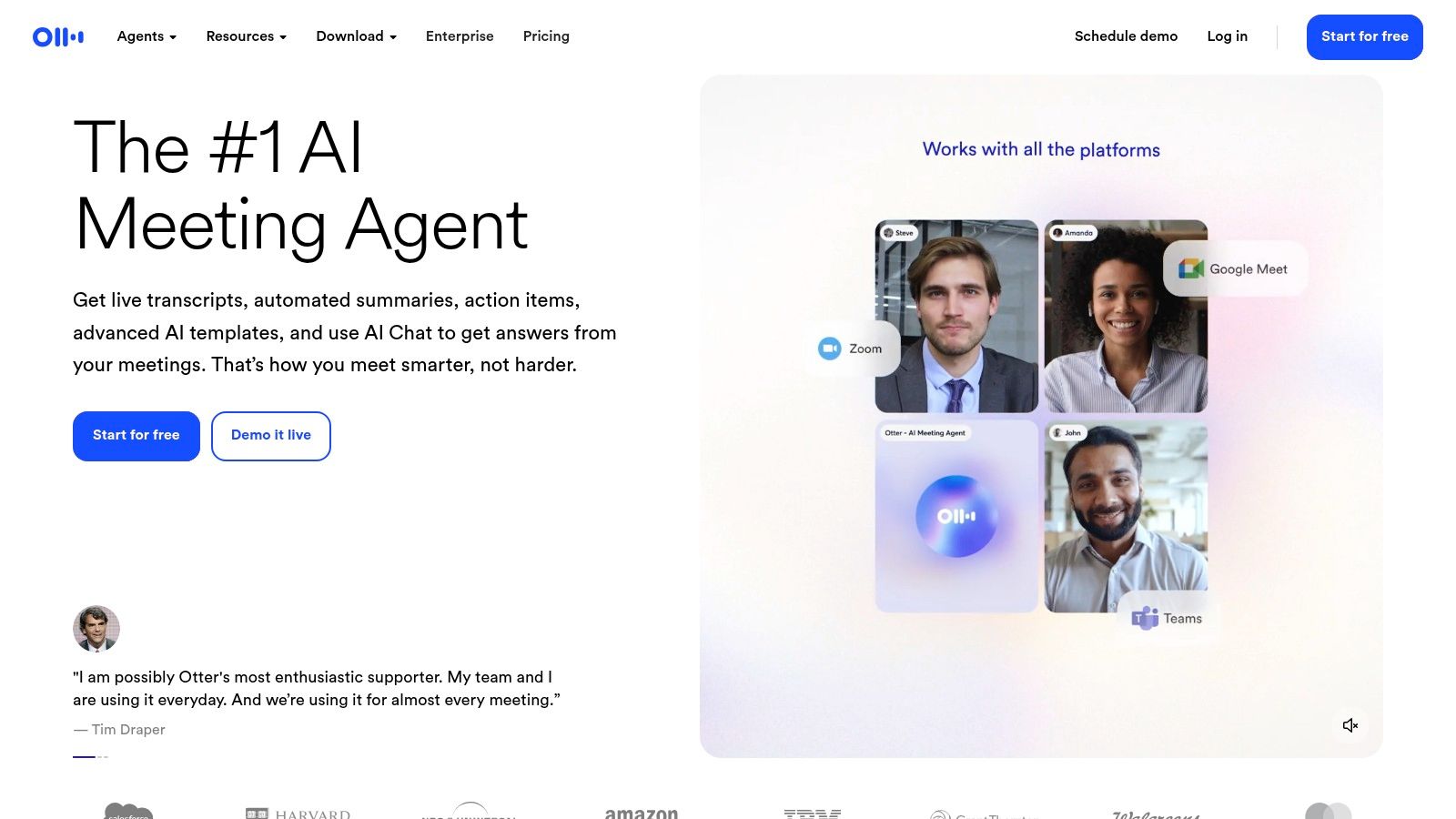
The platform’s strength lies in its intelligence. The "OtterPilot" can automatically join your Zoom, Google Meet, or Microsoft Teams meetings to take notes for you, allowing you to focus on the conversation. After the meeting, you get a fully transcribed, diarized record that you can easily search and share. While the free plan has limits on transcription minutes per month and the duration of each recording, it provides more than enough functionality for students or professionals with moderate meeting schedules.
While its primary function is post-meeting transcription rather than real-time dictation into a document, its accuracy and organizational features are top-notch. For those who prioritize capturing conversational nuances and creating an organized, searchable archive of spoken content, Otter.ai is an exceptional choice that stands out from more general-purpose tools.
Notta.ai positions itself as a powerful, AI-driven meeting assistant and transcription service that offers a generous perpetual free plan. This piece of free speech to text software goes beyond simple dictation by providing tools designed for productivity, such as real-time transcription for live meetings and the ability to upload existing audio or video files for conversion. Its cross-device synchronization ensures that your notes and transcriptions are available on its web platform, mobile apps, and Chrome extension seamlessly.
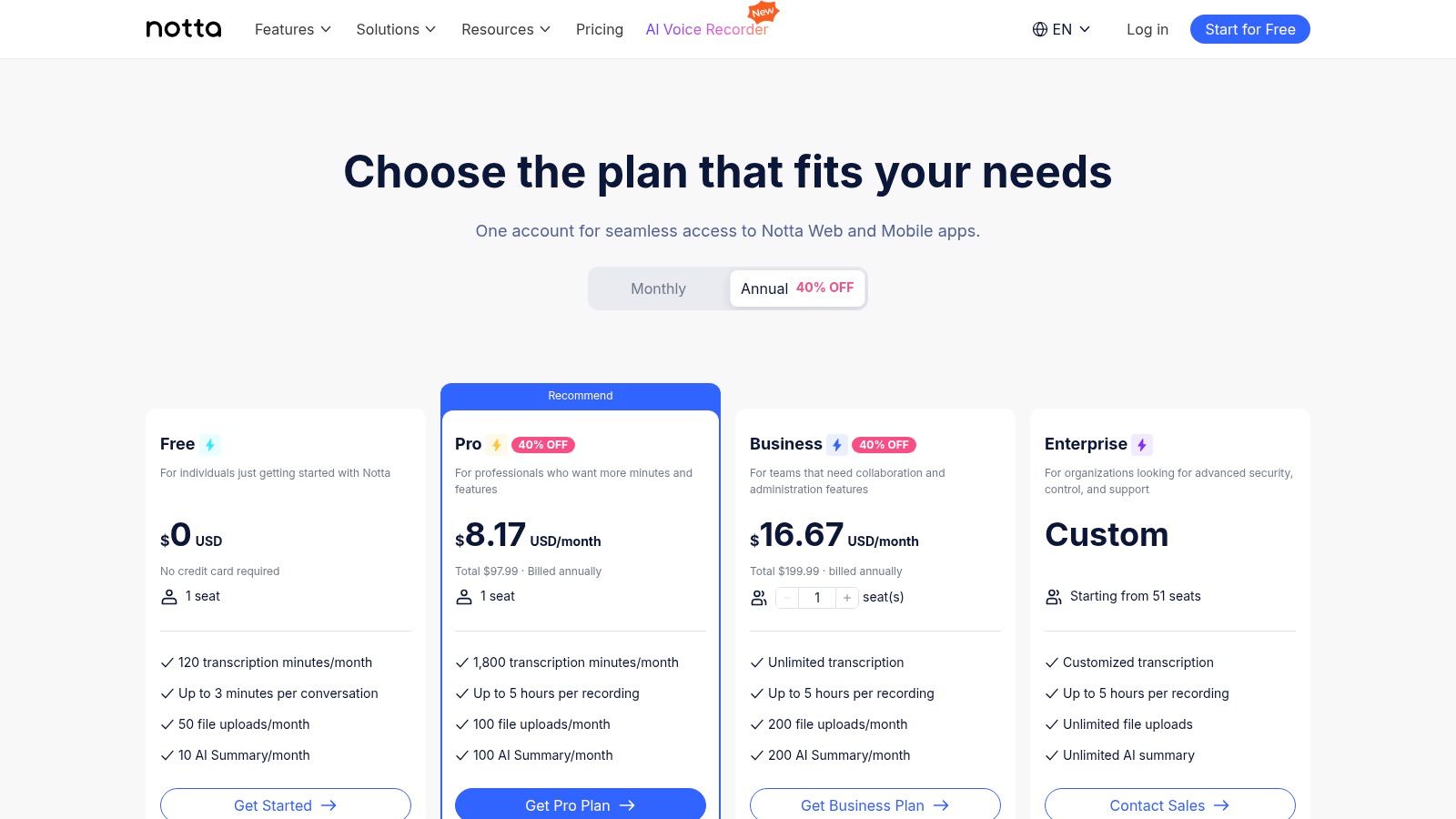
The platform stands out with features typically reserved for paid services, including speaker identification and AI-generated summaries, even on the free tier. While the free plan is limited to 120 minutes per month (with a 3-minute cap per real-time recording), it's more than enough for transcribing short voice memos, interviews, or brief meeting segments. For users needing to capture discussions from Zoom, Google Meet, or Microsoft Teams, Notta's bot can join calls to transcribe them automatically, making it an invaluable tool for students and professionals who need detailed records of their virtual interactions.
For developers and businesses needing programmatic transcription, Deepgram offers a powerful free speech to text software solution through its API. Instead of a standalone application, it provides a developer-focused platform that can be integrated into custom workflows and products. This makes it ideal for building features like automated meeting notes, voice-controlled interfaces, or large-scale audio data analysis. Its unique offering is a generous initial credit of $200 for new users, allowing extensive testing of its advanced models without any upfront cost.
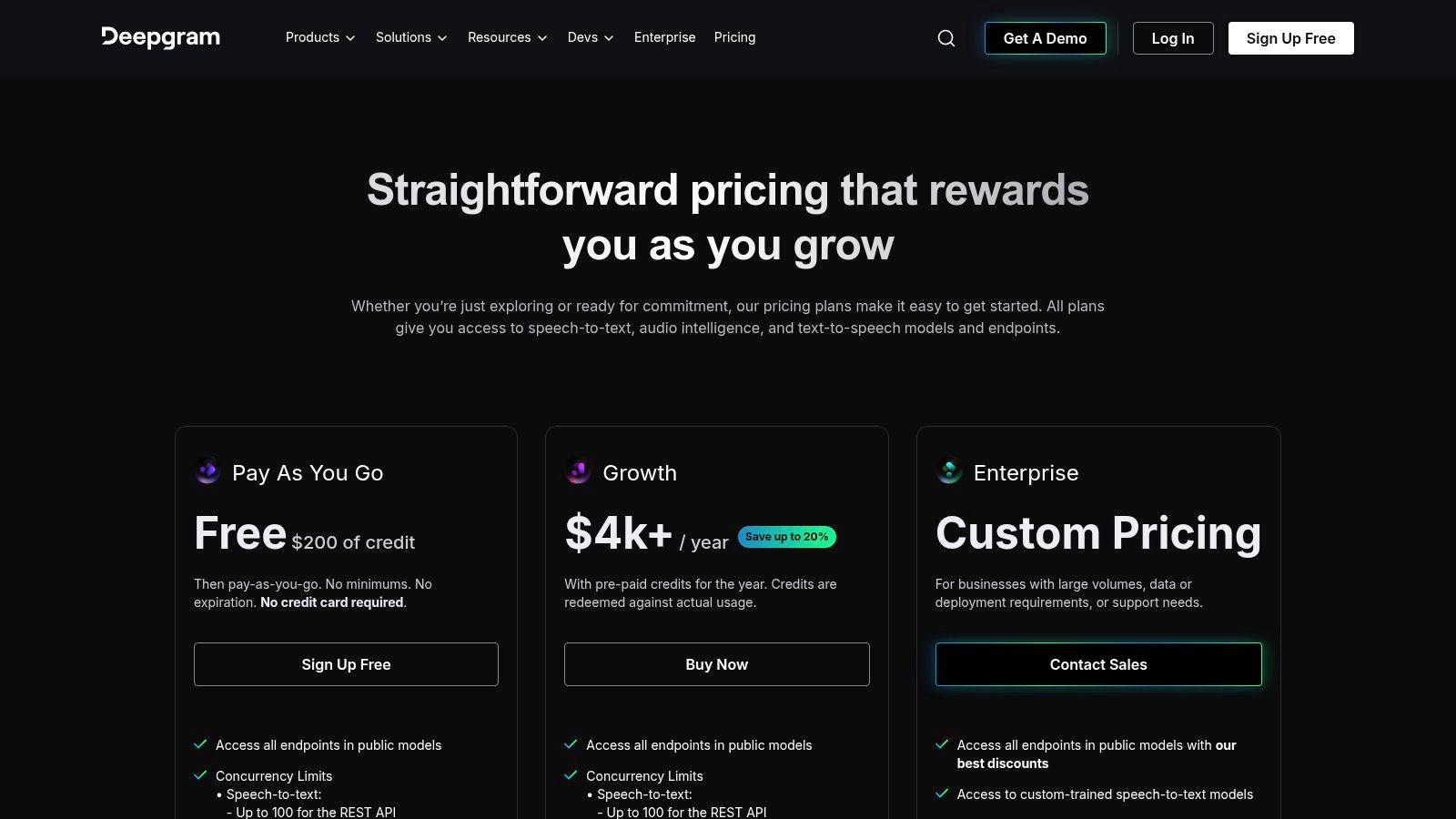
Deepgram supports real-time and batch transcription, speaker diarization (identifying who spoke when), and over 30 languages. It stands out with multiple modern models like Nova-2 and Whisper Cloud, giving developers flexibility to choose the best fit for their accuracy and speed needs. The "Playground" allows for quick, code-free testing of audio files, while comprehensive SDKs simplify integration.
While the free access is a one-time credit rather than a perpetual free tier, it provides more than enough usage to fully evaluate its enterprise-grade capabilities. It's the perfect starting point for developers who need a high-quality, scalable transcription engine and plan to move to a pay-as-you-go model.
For developers and businesses seeking an enterprise-grade solution, IBM Watson offers a powerful free speech to text software tier through its cloud platform. Unlike consumer-focused apps, Watson is an API-driven service designed for integration into applications, providing sophisticated features like speaker diarization (identifying who is speaking) and real-time transcription with interim results. This makes it ideal for building advanced voice-enabled products, from customer service bots to in-app voice controls.
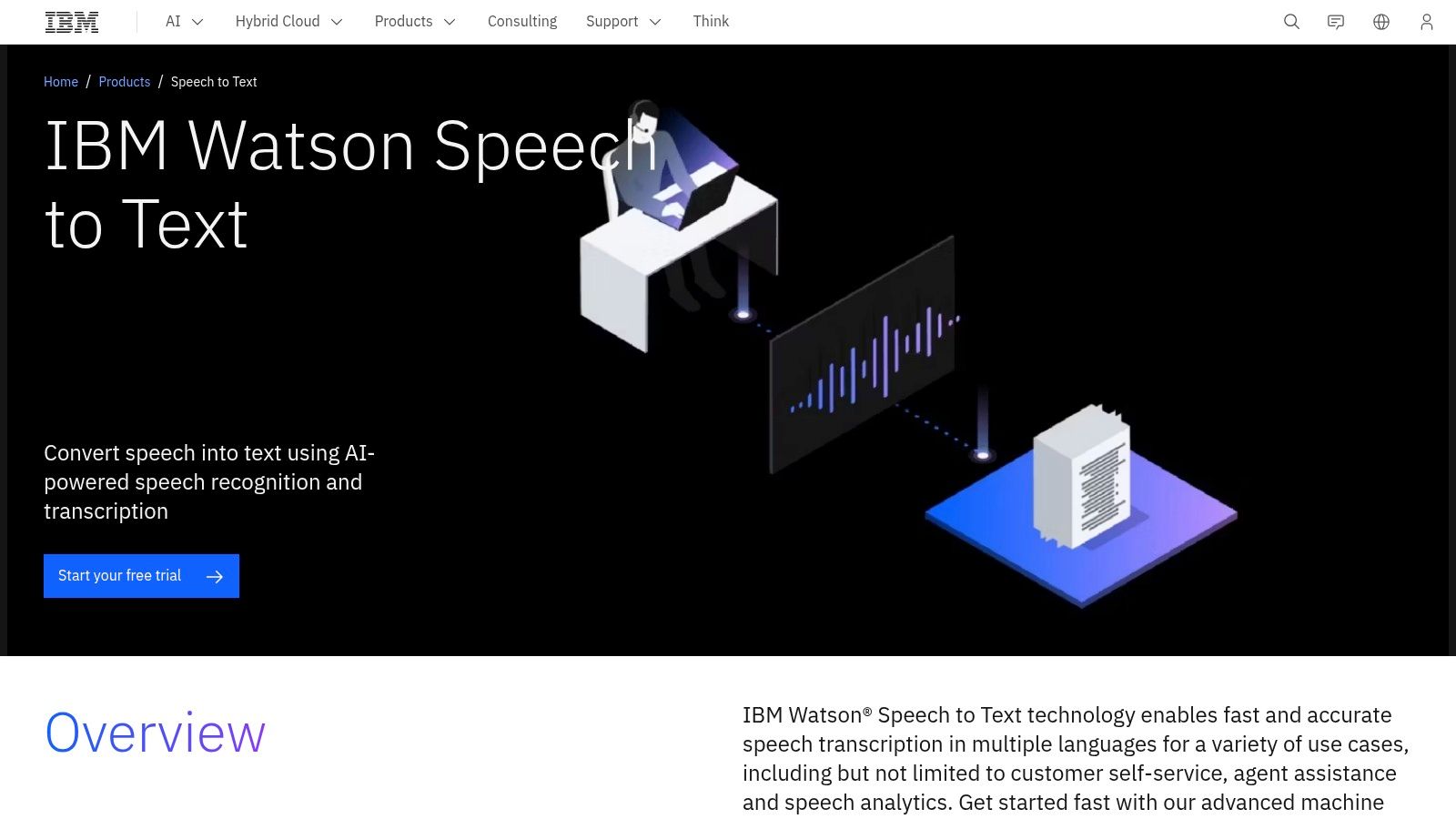
The platform supports over 38 languages and models, with options for cloud or on-premises deployment for enhanced security. While its primary audience is technical, the ongoing "Lite" plan offers 500 free minutes per month, making it an excellent resource for prototyping and small-scale projects without any initial investment. The setup requires creating an IBM Cloud account and working with an API, so it is less straightforward than a simple dictation tool.
However, for those who need to build reliable, scalable transcription features into their own software, IBM Watson provides a robust and highly customizable foundation. It stands out for its accuracy, deployment flexibility, and advanced capabilities that go far beyond basic dictation, positioning it as a top choice for serious development work.
For developers and organizations integrated into the Microsoft ecosystem, Azure AI Speech offers a powerful, API-driven piece of free speech to text software through its generous free tier. This isn't a simple consumer tool but a robust, cloud-based service designed for building applications. The free F0 tier provides 5 audio hours of standard transcription per month, making it ideal for testing, small projects, or low-volume production needs without any upfront cost. Its strength lies in its scalability and advanced capabilities.
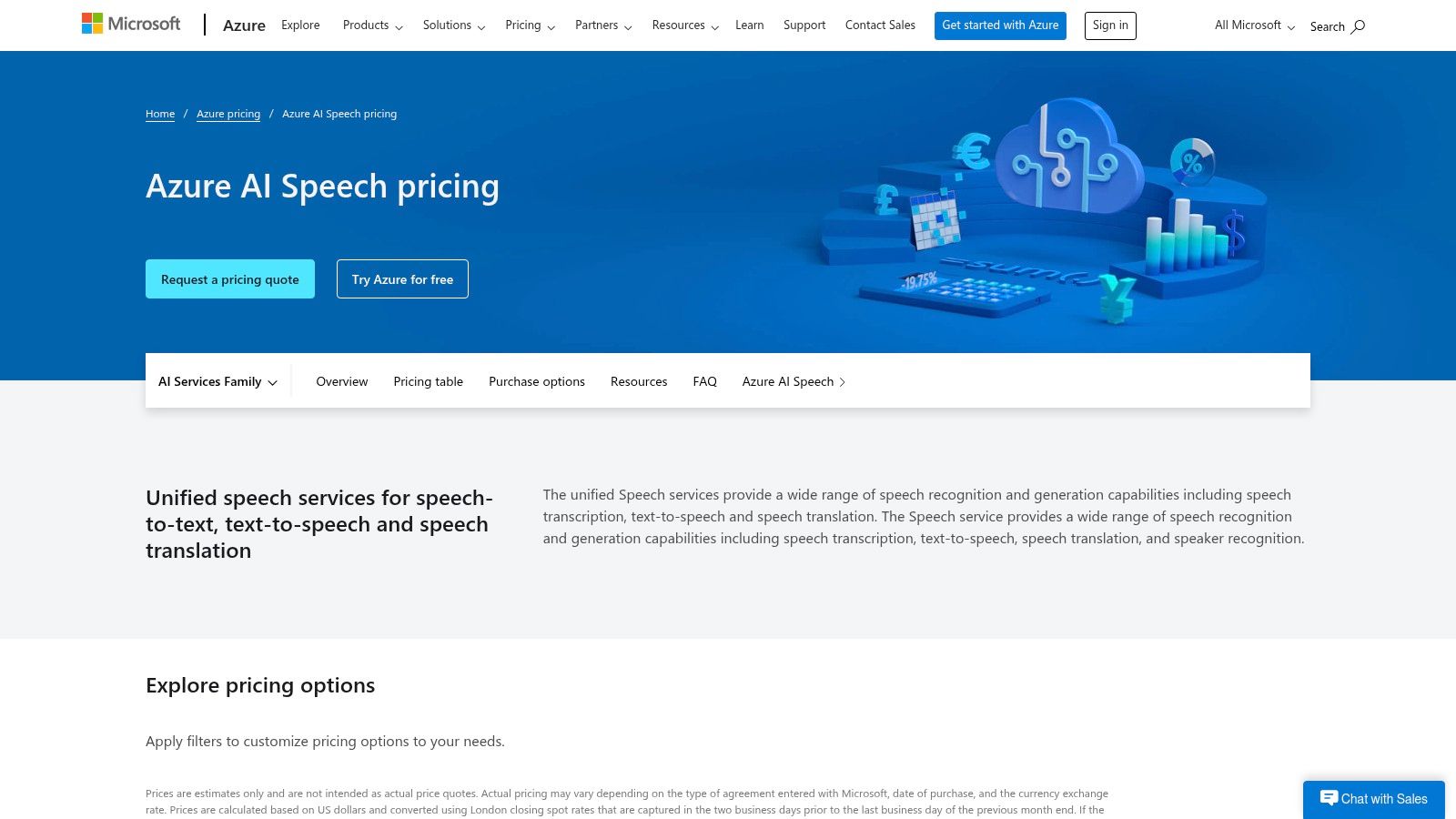
The service supports both real-time streaming and batch processing of audio files, and users can customize models to improve accuracy for specific domains, accents, or acoustic environments. This level of control is rare in free offerings. While setting it up requires an Azure account and some technical knowledge to work with its APIs or SDKs, it provides enterprise-grade reliability and broad language support. After the free allowance is used, billing is metered per second, offering a predictable pay-as-you-go model for scaling up.
For developers and privacy-conscious users, OpenAI Whisper is a revolutionary piece of free speech to text software. It's not a ready-to-use application but an open-source model you can run locally or integrate into your own projects. This self-hosting capability is its defining feature, giving users complete control over their data and eliminating ongoing usage fees. Its accuracy is exceptionally high, rivaling many paid services across a vast range of languages.
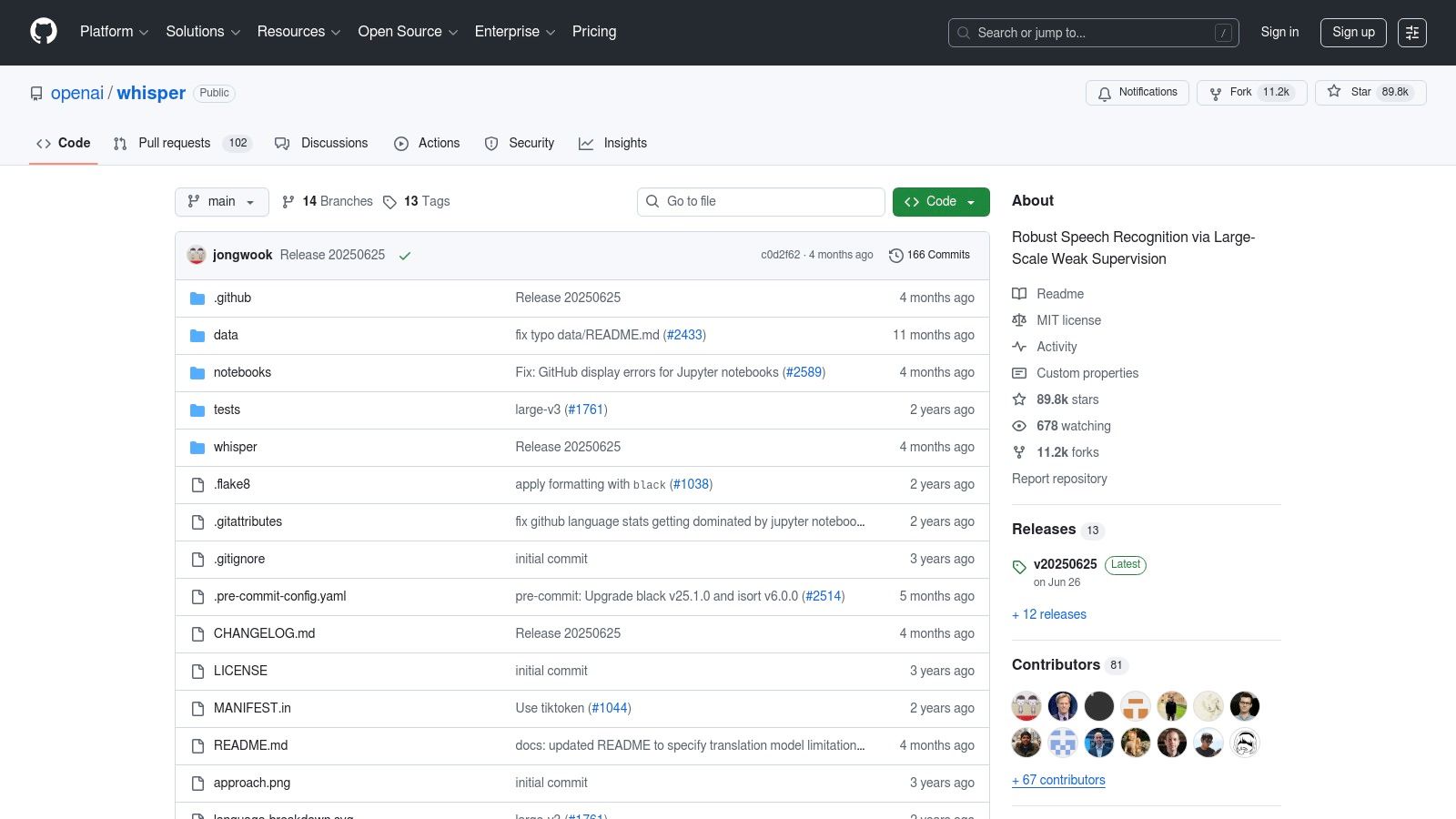
The model comes in various sizes, from "tiny" for low-resource devices to "large" for maximum accuracy, offering flexibility for different needs. It handles transcription, language identification, and even translation from spoken audio. While it requires technical setup and sufficient computing power (especially for larger models), its performance is outstanding. It is the ideal solution for anyone needing a powerful, private, and customizable transcription engine without the cost of a commercial API.
For developers and privacy-conscious users who need a powerful offline solution, whisper.cpp is a remarkable piece of free speech to text software. It's a highly optimized C/C++ port of OpenAI's Whisper model, designed for high-performance transcription directly on your local machine. This approach guarantees complete data privacy since your audio never leaves your device, making it ideal for sensitive content. It runs on Windows, macOS, and Linux with broad hardware support.
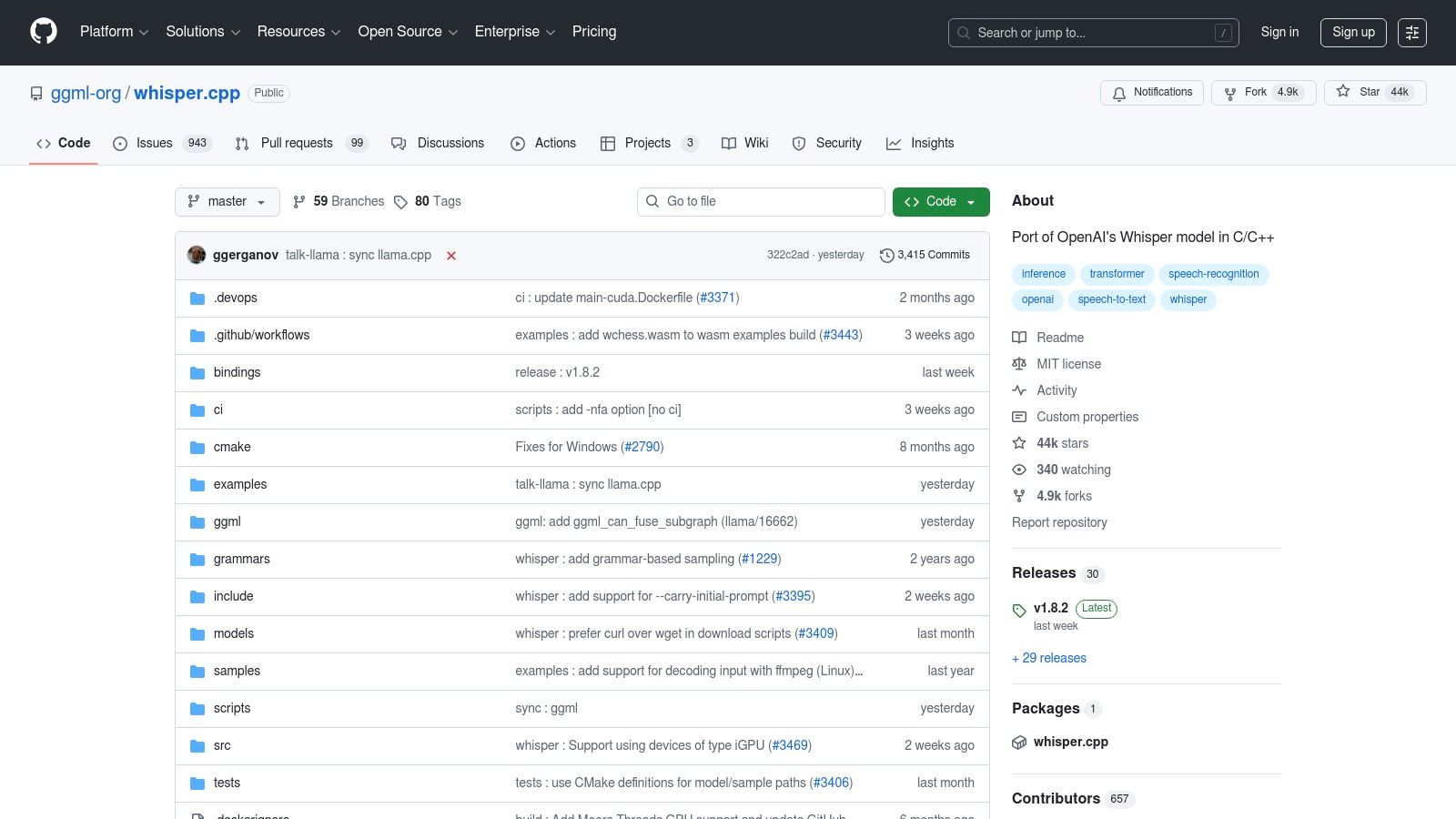
The key advantage of whisper.cpp is its efficiency. It supports various quantized models that run effectively on low-resource hardware, including older CPUs, without sacrificing too much accuracy. For those with powerful systems, it leverages GPU acceleration via CUDA, CoreML, and other backends for blazing-fast performance. Users interact with it through the command line, feeding it audio files or even using it for simple live transcription from a microphone.
While it's not a point-and-click application and requires some technical comfort with command-line tools, its performance and privacy are unparalleled in the free software space. It is the go-to choice for anyone looking to integrate state-of-the-art transcription into a local application or workflow without relying on cloud services.
For developers and privacy-conscious users, Vosk is a powerful, offline, open-source free speech to text software toolkit. Unlike cloud-based services, Vosk runs entirely on your device, from servers and desktops to mobile and embedded systems like a Raspberry Pi. This offline capability ensures that your data remains private and provides extremely low-latency transcription, making it ideal for real-time applications where a cloud round-trip is not feasible.
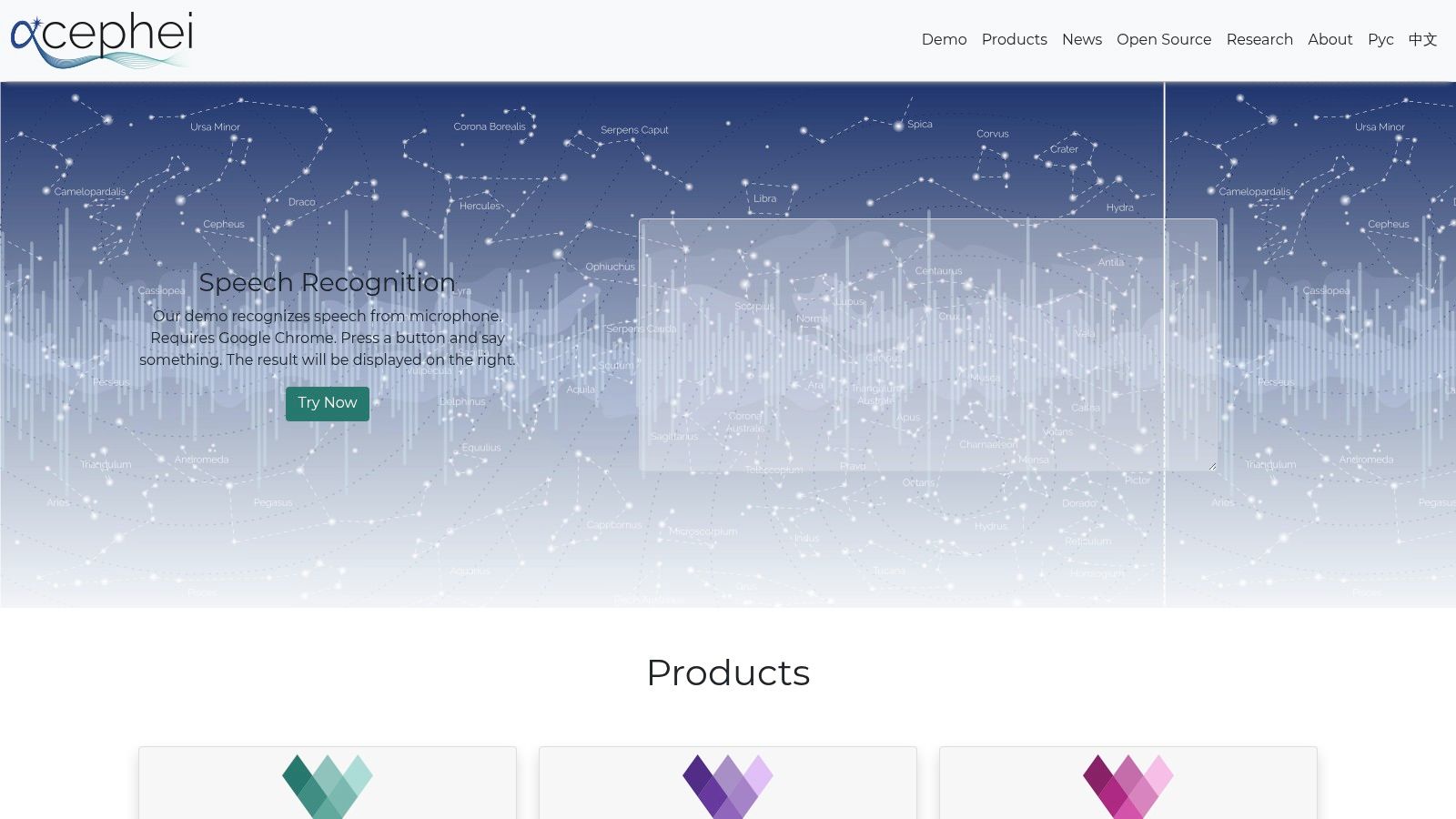
Vosk supports over 18 languages with various model sizes, allowing developers to choose the right balance between accuracy and resource consumption for their specific project. While its setup is more technical and aimed at those comfortable with programming, it offers unparalleled control and flexibility. It is not a ready-to-use consumer app but a foundational technology for building custom voice-enabled products. This makes it a perfect choice for creating voice assistants, transcribing audio in secure environments, or adding voice controls to custom hardware without relying on an internet connection.
Speechnotes is a minimalist, browser-based notepad designed for one purpose: turning your voice into text with zero friction. As a piece of free speech to text software, it stands out for its simplicity and accessibility. There are no sign-ups, no downloads, and no complex menus to navigate. You simply open the website, click the microphone, and start speaking. The platform leverages your browser’s built-in speech recognition engine, transcribing your words directly into a clean, distraction-free text area.
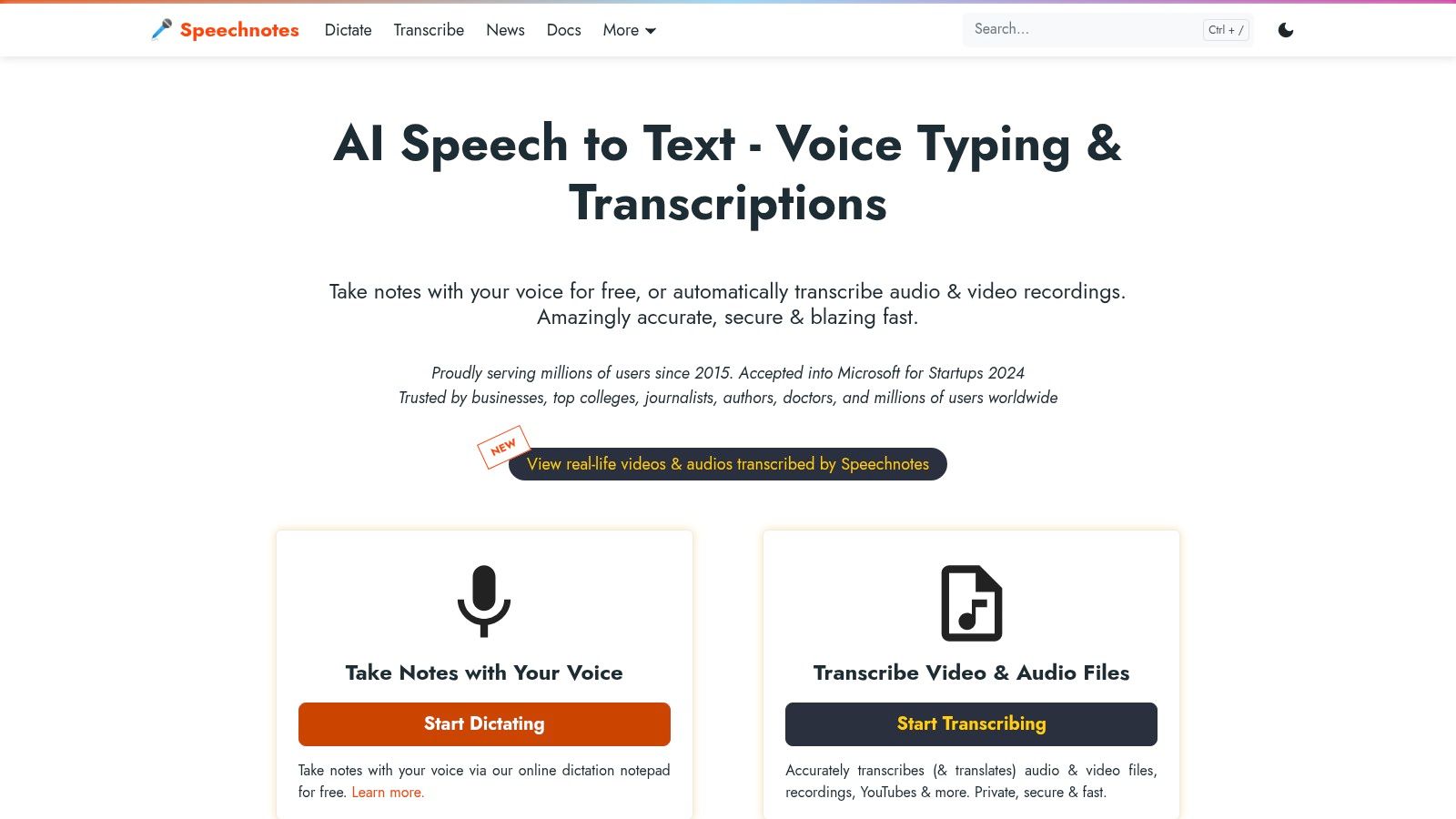
The interface includes clever features for quick note-taking, such as voice commands for punctuation (e.g., saying "period" or "comma") and an auto-save function that ensures your work is never lost. Once finished, you can easily copy the text, download it as a .txt file, or upload it directly to Google Drive. While it isn't built for transcribing multi-speaker meetings or complex audio files, Speechnotes is an exceptional tool for anyone needing to quickly dictate thoughts, draft an email, or capture ideas without the overhead of a full-featured word processor.
| Product | Core features ✨ | Quality / UX ★ | Pricing / Value 💰 | Target audience 👥 | Standout 🏆 |
|---|---|---|---|---|---|
| Google Docs – Voice Typing | Browser dictation, formatting commands, multi‑language | ★★★☆ — accurate for clear speech | 💰 Free (Google account) | 👥 Casual writers, students | 🏆 Instant in‑doc dictation |
| Windows 11 – Voice Typing / Voice Access | System-wide dictation, Voice Access, auto‑punctuation, offline option | ★★★☆ — best on Win11, accessibility focused | 💰 Included with Windows 11 | 👥 Windows users, accessibility needs | 🏆 Offline PC control |
| Apple Dictation (iPhone/iPad/Mac) | System-wide dictation, on‑device processing, auto‑punct | ★★★★ — fast & private on Apple devices | 💰 Free on Apple hardware | 👥 Apple ecosystem users | 🏆 On‑device privacy & speed |
| Otter.ai | Real-time & file transcription, speaker ID, integrations, summaries | ★★★★ — polished UI, strong diarization | 💰 Free tier (limits); paid plans | 👥 Teams, meeting note takers | 🏆 Meeting workflows & integrations |
| Notta.ai | Real-time/file transcription, recorder bot, Chrome ext., summaries | ★★★☆ — simple meeting capture | 💰 Perpetual free plan (limits) + paid tiers | 👥 Individuals & small teams | 🏆 Chrome extension & sync |
| Deepgram (API) | Real-time & batch API, diarization, SDKs, modern models | ★★★★ — dev‑friendly, low latency | 💰 $200 free credits; pay‑as‑you‑go | 👥 Developers, enterprises | 🏆 Developer tools & modern models |
| IBM Watson STT | Diarization, customization, cloud/on‑prem options, multiple models | ★★★☆ — enterprise feature set, needs setup | 💰 Lite tier (recurring free minutes) + paid | 👥 Enterprises needing customization | 🏆 Enterprise deployment & SLAs |
| Microsoft Azure AI Speech | Streaming & batch, SDKs, model customization, F0 free tier | ★★★★ — scalable, Azure‑integrated | 💰 F0: 5 audio hrs/mo free; metered after | 👥 Azure customers, orgs | 🏆 Azure ecosystem & SLAs |
| OpenAI Whisper (open-source) | Multilingual STT, multiple sizes, CLI/Python, self‑hostable | ★★★☆ — strong accuracy; compute‑heavy | 💰 Free to run locally (compute cost) | 👥 Developers, privacy‑conscious | 🏆 Open‑source & flexible |
| whisper.cpp (C/C++) | Offline C/C++ port, quantized models, CPU/GPU accel, CLI | ★★★☆ — fast on CPU, CLI‑oriented | 💰 Free (local compute only) | 👥 Edge developers, low‑resource setups | 🏆 Optimized for low‑resource hardware |
| Vosk (Alpha Cephei) | Offline toolkit, mobile/embedded support, multiple languages | ★★★ — low latency; accuracy varies by model | 💰 Free & offline | 👥 Embedded/mobile developers | 🏆 Edge‑friendly, multi‑platform offline |
| Speechnotes | Browser notepad, voice punctuation, auto‑save, quick export | ★★★ — extremely quick start, browser‑dependent | 💰 Free core; optional extras | 👥 Casual note‑takers | 🏆 Minimal friction for quick notes |
Navigating the landscape of free speech to text software reveals a spectrum of powerful options, each tailored to different users and objectives. Our journey through built-in system tools, dedicated transcription services, and robust APIs has shown there is no single "best" solution. Instead, the ideal choice hinges entirely on your specific context, technical requirements, and long-term goals.
For casual users, students, or content creators needing quick, straightforward transcription, the tools built directly into your operating system are often the perfect starting point. Google Docs Voice Typing, Apple Dictation, and Windows 11 Voice Typing offer remarkable accuracy for everyday tasks at zero cost, seamlessly integrated into the workflows you already use. Their primary limitation is the real-time, manual nature of the transcription process, making them less suitable for processing large volumes of pre-recorded audio.
When your needs evolve to include transcribing meetings, interviews, or lectures with features like speaker identification and collaborative tools, services like Otter.ai and Notta.ai shine. Their generous free tiers provide a fantastic entry point to experience the power of automated, multi-speaker transcription, though they often come with limitations on monthly minutes and advanced features that encourage upgrading to a paid plan.
For developers, startups, and businesses, the conversation shifts from simple tools to scalable infrastructure. The "free" aspect here transitions from fully-featured applications to the generous free tiers offered by major cloud providers and the open-source community. This is where the true power of programmatic speech-to-text is unlocked.
Your decision-making process in this category should be guided by several key factors:
Ultimately, the path forward involves experimentation. Start with the most accessible tool that meets your immediate needs. Don't be afraid to test the limits of a free tier or spin up an open-source model for a pilot project. By aligning the tool's strengths with your unique use case, you can harness the transformative power of voice technology to enhance productivity, unlock insights, and build innovative applications.
If you're a developer seeking a high-quality Speech-to-Text API that balances world-class accuracy with affordability, consider exploring Lemonfox.ai. We provide a simple, powerful, and cost-effective alternative to major providers, allowing you to scale your projects without compromising on performance. Check out our developer-friendly API and competitive pricing at Lemonfox.ai.